|
|
|
Sort Order |
|
|
|
Items / Page
|
|
|
|
|
|
|
| Srl | Item |
| 1 |
ID:
134060
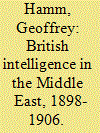

|
|
|
|
|
| Publication |
2014.
|
| Summary/Abstract |
This article examines British intelligence efforts in Turkish Arabia at the turn of the twentieth century. It argues that intelligence collection was really three separate efforts, carried out by the War Office, the Foreign Office, and the Government of India, and it reflected concerns about British decline, the problems experienced during the Boer War, as well as an effort to penetrate the 'information order' of India's sub-empire. Although intelligence efforts suffered from bureaucratic disharmony in Whitehall, and between London and the Government of India, valuable contributions were nevertheless made to Britain's knowledge of Turkish Arabia.
|
|
|
|
|
|
|
|
|
|
|
|
|
|
|
|
| 2 |
ID:
132443


|
|
|
|
|
| Publication |
2014.
|
| Summary/Abstract |
For competitive and business intelligence, as for covert or military intelligence, the term "intelligence" connotes a combination of raw data, technology, and analysis resulting in intelligence deliverables such as reports and profiles. For all intelligence fields, the primary purpose of intelligence is to inform decisionmaking, with the intent of increasing the likelihood of the most optimal outcomes for the organization. 1 Competitive intelligence in the business sector is sometimes called by other labels, such as business or market intelligence. 2 It involves surveying and monitoring the competitive environment and developing intelligence to inform decisionmaking.
|
|
|
|
|
|
|
|
|
|
|
|
|
|
|
|
| 3 |
ID:
149705
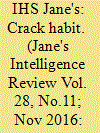

|
|
|
|
|
| Summary/Abstract |
Advances in quantum cryptography raise the prospect of genuinely undecryptable communications. In the second of an occasional series on future intellence collection, IHS Jane's analyses how unbreakable digital security might change espionage.
|
|
|
|
|
|
|
|
|
|
|
|
|
|
|
|
| 4 |
ID:
140481


|
|
|
|
|
| Publication |
New Delhi, Lucky International, 2012.
|
| Description |
xvi, 196p.hbk
|
| Standard Number |
9788191060720
|
|
|
|
|
|
|
|
|
|
|
|
Copies: C:1/I:0,R:0,Q:0
Circulation
| Accession# | Call# | Current Location | Status | Policy | Location |
| 058279 | 322.420954/KUM 058279 | Main | On Shelf | General | |
|
|
|
|
| 5 |
ID:
151776
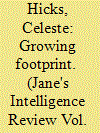

|
|
|
| 6 |
ID:
161535
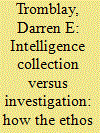

|
|
|
|
|
| Summary/Abstract |
There is an inherent tension between a law enforcement–driven approach and a requirementsdriven approach to intelligence collection. The US experience, with the development of the Federal Bureau of Investigation(FBI), as the primary intelligence service within the domestic environment, suggests that the tension is nearly insurmountable if an organization starts from a reactive, threat-focused posture. As a law-enforcement agency, which US government decision-makers expect to fulfill an intelligence function, the FBI is triply handicapped by the external strictures of the Department of Justice (DoJ); the Bureau’s own policies – which respond to the DoJ parameters; and the FBI’s organizational culture.
|
|
|
|
|
|
|
|
|
|
|
|
|
|
|
|
| 7 |
ID:
132431
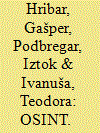

|
|
|
|
|
| Publication |
2014.
|
| Summary/Abstract |
Open Source Intelligence (OSINT) is generally seen in positive terms, particularly as a method of conventional intelligence collection that does not violate human rights. Of all the data collection methods, OSINT is, arguably, the only fully legal method. It can be conducted anytime, anywhere, and with any (legal) tools/software, as long as it does not violate human rights. In principle, however, OSINT does not and should not violate human rights, therefore such tools are all, again arguably, legal. Thus, its legality makes OSINT globally available, including to markets around the world. The free market offers various legal tools that facilitate the analytical procedures of data acquisition and analysis, and which no longer represent a major technical and logistical obstacle. Hypothetically, OSINT can be carried out by anyone with such specific tools and knowledge. These tools can be obtained by anyone free of charge or by paying for the licensed program, while the knowledge necessary to conduct OSINT is relatively easily acquired. Even though the tools and knowledge are freely accessible, the major difference between basic and excellent OSINT "operations" lies in the analytical process. Only experts with good analytical skills and knowledge manage to provide the right information at the right time to their customers/policymakers. OSINT is also a formal tool and means of analytical support in the work of intelligence services. Intelligence service analysts are capable of the advanced use of OSINT-they are familiar with specialized sources of specific data, advanced techniques of acquiring data, and the analytical steps needed for successful processing, exploitation, and analysis of massive amounts of data. The exploitation of special sources and the use of advanced techniques make OSINT questionable when seen through the prism of legality. The exploitation is at times semi-legal or even, arguably, illegal. The use of "special" techniques in OSINT can therefore lie on the edge between the legal and the illegal. These actions are sometimes clearly illegal, of course, and therefore forbidden by the criminal law; such practice by the intelligence services is not sanctioned. This raises the following questions: Could the intelligence services using OSINT in a legal manner to serve their specific individual interests interfere in another country on the ground of this same legality? Without this hypothetical "grey zone" would they be acting illegally and so become subject to counterintelligence observation?
|
|
|
|
|
|
|
|
|
|
|
|
|
|
|
|
| 8 |
ID:
115195
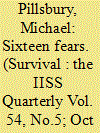

|
|
|
|
|
| Publication |
2012.
|
| Summary/Abstract |
During the Cold War, an influential group of American defence planners sought to understand Soviet defence decisions by grasping the Soviet mind, including exploring how the Soviet generals thought about war and their opponents. This was achieved only through intensive intelligence collection and intellectual analysis, including extensive use of open sources. It was a process which, as George Kennan put it in his analysis of Soviet thinking, 'would require living with contradictions'.
|
|
|
|
|
|
|
|
|
|
|
|
|
|
|
|
| 9 |
ID:
119276
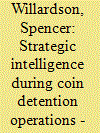

|
|
|
|
|
| Publication |
2013.
|
| Summary/Abstract |
One aspect of the global "War on Terror" that has received limited coverage in the academic literature is the problem of detained persons as it relates to intelligence. This is a surprising oversight, given the number of detainees that the USA has been responsible for (over 25,000 were in custody in Iraq alone at one time during its peak). The detention environment offers a prime strategic intelligence opportunity for the US intelligence community to study the tactics and organizations of individuals who have been removed from the overall conflict. In this article an easily implemented collection program is recommended to be deployed in US/coalition detention centers. The primary recommendation is to gather relational data on detainee communication, both authorized and illicit, and to use these data to perform network analyses of terrorist groups and their individual members.
|
|
|
|
|
|
|
|
|
|
|
|
|
|
|
|
| 10 |
ID:
127455
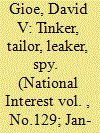

|
|
|
|
|
| Publication |
2014.
|
| Summary/Abstract |
BETWEEN THE TRIAL of Chelsea (formerly known as Bradley) Manning and the revelations of Edward Snowden, the debate regarding the leakers and their information has focused primarily on the balance between liberty and security, or between government transparency and secrecy. This is a necessary, even overdue, discussion. But it is also important to reflect upon the lasting damage these unauthorized disclosures will have on future U.S. intelligence collection.
|
|
|
|
|
|
|
|
|
|
|
|
|
|
|
|
| 11 |
ID:
171244
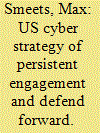

|
|
|
|
|
| Summary/Abstract |
This article evaluates the implications of U.S. cyber strategy of persistent engagement for the alliance and intelligence collection. Whilst the strategy may have benefits for certain alliance relationships, I identify four potential negative consequences; loss of allied trust, disruption allied intelligence operations and capabilities, exploitability of the strategy by adversaries, and the implementation (and justification) of persistent engagement by other countries. This paper concludes suggesting several ways forward, including the creation of a new NATO-memorandum of understanding on cyber operations.
|
|
|
|
|
|
|
|
|
|
|
|
|
|
|
|
|
|
|
|
|